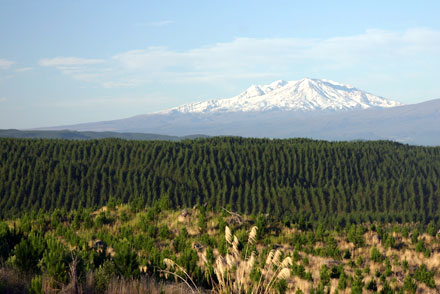
The forestry and logging sector is worth NZ$1.4 billion to GDP, making a substantially larger contribution than either the sheep meat or beef sectors, says a new report released in Rotorua. Sources: The New Zealand Herald, Rotorua Daily Post
The report was commissioned by the New Zealand Forest Owners Association and Farm Forestry Association from NZIER.
Forest Owners Association chairman Peter Clark said the public had underestimated the forest sector’s role and importance.
“Our sector is growing faster than horticulture,” he said. “For the first time since 1882 … the value of our forest product exports is now exceeding the total value of red meat exports. That represents a sea change in our primary export mix.”
The Ministry of Primary Industries forecasts that New Zealand forest product export returns will reach $6.15 billion by 2020, from $5.14 billion in 2016.
Increasing returns from sawn timber, wood panels, pulp and paper, would all contribute to the growth. However, NZIER noted the fact that the significant environmental contribution of forestry was not usually factored into its economic value, and the lack of a ministry or department dedicated to forestry, were both constraints on the industry.
NZIER recommended the establishment of a “satellite account” to reflect the growing importance of this sector.
Satellite accounts extend existing information on industries to include social and environmental values, and would assist in reflecting forestry’s wider benefit to New Zealand, the report said.
Mr Clark said currently everybody, including NZIER, was making assumptions based on some studies in some regions.
“The Government’s Biodiversity Action Plan 2016-20 set 2017 as the target date to investigate the need and potential to produce New Zealand environmental-economic accounts,” he said.
“So, in implementing this undertaking, we’d love to see the Government put the environmental ruler across our forest sector.”
Rotorua mayor Steve Chadwick said Rotorua Lakes Council was the first and so far only local body to promote a Wood First Policy. She noted about 40% of the country’s wood was harvested within a 100km radius of the city. And she was fully supportive of NZIER’s suggestion that a satellite account for forestry be established.
“The industry needs positive support from Government and for that to happen, the industry needs to be able to quantify its worth,” she said.
Forest Owners Association chief executive David Rhodes said the report’s release was timely, given the increasing interest in environmental issues, and the Government’s focus on regional development.
“The contribution the forest sector is making in some regions is quite significant,” he said. “We are hoping to get across through the report that there are a whole bunch of things that forestry delivers, which aren’t being reflected in the market statistics and GDP figures.”
According to the report, wood production has risen from 10 million cu m of timber in 1989, to 28.7 million cu m last year.
However, Bryce Heard, chairman of the Forest Wood Action Group, part of Bay of Connections, said wood supply was being forecast to diminish as a result of conversion to dairy and lack of replacement planting.
The wider Bay of Plenty region was cutting around 12 million cubic metres a year, which was expected to drop to around 10 million cubic metres by the year 2030 on current projections, he said. “We’re busily trying to get people to invest in processing, but they look at 10-15 years out and ask where the wood’s going to come from,” he said. “It’s not a good scenario for increasing processing.”
Services such as carbon storage, erosion control, water quality, biodiversity and recreation could provide NZ$9.6 billion of ecological and social value from plantation forestry to New Zealand every year, the report says.





